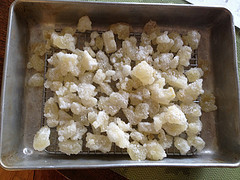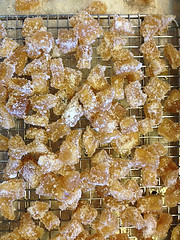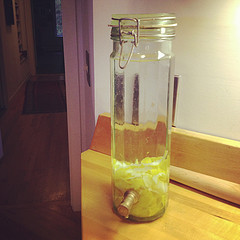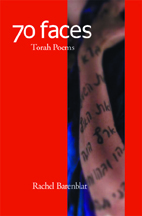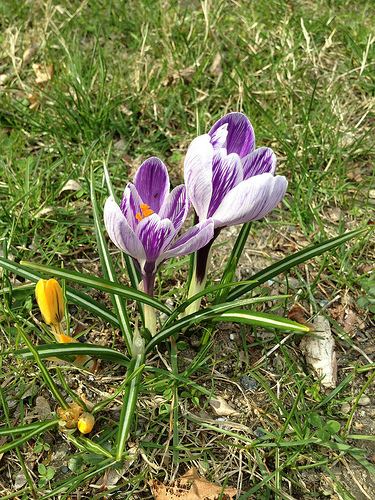Rachel Barenblat's Blog, page 210
October 15, 2012
A pantoum for parashat Noach
We've entered parashat Noach. This week's parsha contains the story of the great Flood! There's a lot of good stuff in this week's Torah reading.
Three years ago I posted a Torah poem for this portion which I still quite like. (And it's not the one which wound up in 70 faces, either. I like them both.) Here's how it begins:
Noah walked with God.
He was a righteous man.
He was blameless in his age.
Noah begot three sons.
He was a righteous man
though his era was lawless.
Noah begot three sons
and the earth became corrupt.
Though his era was lawless
he found love in Na'amah.
The earth became corrupt
but she sang so sweetly...
Read the whole thing: Blameless.
October 14, 2012
Thanks, Shot Glass Journal

Another of my mother poems has been published -- this time in Shot Glass Journal, an online magazine dedicated to publishing short poetry. As the editor, Mary-Jane Grandinetti, writes:
Why only short poetry? It is far more difficult to capture a message in
fewer words and still have an effect on a reader. Shot Glass is
dedicated to those poets who have much to say in the fewest words
possible.
My poem is in issue #8, which just went live. You can read it here: Grandparents' House. Thanks, Mary-Jane!
October 12, 2012
Candied citron / dulce de etrog
Earlier this week I got this year's batch of etrogcello underway. But what to do with the etrogim after I'd carved away the yellow part of the peels?
This year's answer is candied etrog. I found two recipes which looked interesting. One comes from chef David Lebovitz: candied citron. The other is this dulce de etrog recipe.
I diced the peel and soaked it overnight in water, then replaced the water and soaked some more. I brought it to a simmer, drained the water, and then put the etrog in a heavy-bottomed pot with water and sugar. Then I clipped on the candy thermometer and let the peel-sugar-water mixture simmer until it reached 230. Once we hit that magic number, I removed the pot from heat.
David's recipe suggested letting the peel sit in the syrup for an hour, so I did that. I had planned to then remove the peel and drain it, but after an hour I found that the peel-and-syrup mixture had hardened into a kind of jelly, so I went with the dulce de etrog recipe's suggestion of spooning the mixture out onto a sheet of parchment paper to rest overnight.
I rested it in the fridge, mostly because we sometimes have ants and I knew they would find it if it were sitting out in the kitchen. In the morning it was lovely and stiff from the cold. I cut it into little pieces (the jelly became softer as it warmed, but remained jelly-like, never melting altogether) and rolled them in sugar.
Candied citron / dulce de etrog.
The end result are pieces of etrog candy of varying shape and size, now drying on a drying rack. I'll seal them in an airtight container later today. The candies are sweet and citron-y, but not bitter. They're delicious.
Unlike the etrogcello, these won't keep for a long time. We'll probably feed them to this weekend's houseguests. I feel good about finding a way to use, and savor, these precious and rare fruits. A little taste of Sukkot now that Sukkot is only memory.
And I still have two more etrogim to use! I think I might try spicing these with star anise and peppercorns, as in this Pierre Herme recipe. Yum.
Edited to add: the second batch was cooked in a syrup with peppercorns, a star anise, one hot pepper, and a bit of brown sugar to complement the white sugar. They turned out beautiful, too:
Spiced candied etrog peel.
Shabbat shalom!
October 11, 2012
"Curls of peel / prepare to sleep..."
ETROGCELLO
curls of peel prepare to sleep
beneath cold vodka snow-thick blanket
shreds of autumn gold and gleaming
in this womb with no umbilicus
this dark cupboard a sweet relief
close fevered eyes let changes come
to unfurl bright upon our tongues
as springtime's sap begins to rise
Yes, I am once again making etrogcello! (Here's a glimpse of last year's.)
These slivers of etrog peel will rest under vodka in the dark through the winter. Shortly before Tu BiShvat, the New Year of the Trees, I'll strain and sweeten the results: maybe with splenda syrup, as in previous years -- or maybe with local honey, as my friend Bob does.
We'll sip the bright home-made limoncello at our Tu BiShvat seder, a link between this autumn's harvest and the first stirrings of the coming spring.
Jen Marlowe, "The Hour of Sunlight," is coming to town
I picked up The Hour of Sunlight: One Palestinian's Journey from Prisoner to Peacemaker -- by Sami Al Jundi and Jen Marlowe -- after reading a review of the book in The Jewish Daily Forward. The review is by Israeli-American Emily L. Hauser, and here's how it begins:
Americans often hear about Israel, the Israeli-Palestinian conflict, and the U.S.-Israel relationship. We read Israeli authors in translation, buy Israeli products, and anyone within driving distance of a JCC can hear an Israeli speak on a nearly weekly basis.
What we don't often hear are Palestinians.
This is, I believe, understandable — particularly for the Jewish community. We want to know more about ourselves, our brothers and sisters, our homeland. We want to support our people and our future. We know the story, and don't feel a need to hear the version told by Israel's enemies.
But perhaps that's exactly why we do need to consider Palestinian voices — because after all these years, Israel and the Palestinian people are still enemies.
(Read her whole review here: Hearing Palestinian Voices.) Reading Emily's review made me curious about the book, so I picked up a copy last winter, and last spring I shared my own review (Book review: The Hour of Sunlight.) In my post about the book last March, I wrote:
This book wasn't always easy for me to read, but it is powerful and it is worth reading, especially for anyone who (like me) may have more access to Israeli narratives about the Middle East than to Palestinian ones.
My review reached the attention of Jen Marlowe, the American co-author of the book. I learned that she'd actually given a reading in Williamstown in recent memory, which I had somehow missed. And then she mentioned that she would be happy to return to the Berkshires to share the book and to engage in conversation about it, if there were interest.
This coming weekend, a coalition of local organizations -- the First Congregational Church of Williamstown, the Jewish Association at Williams College, the Jewish Federation of the Berkshires, and my congregation -- are partnering to bring Jen Marlowe back to northern Berkshire.
On Sunday night at 8pm she'll speak at First Congregational Church in the Fellowship Hall. She'll share words about the book and how it was written (we're hoping that if we can get the audio-visual setup to work, she can also show a short video of her co-author Sami al-Jundi) and will read an excerpt from the book, after which she'll take questions and sign books. On Monday evening at 7pm, she'll come to Congregation Beth Israel to discuss the book informally with people who've read it or are in the process of reading it.
It's something of a truism these days to say that Israelis and Palestinians, and the Diaspora communities who feel connected with those two communities, have different narratives and that understanding one another's narratives is part of the path to peace. Still, cliché or no, I believe it. Generally speaking, my community and the Palestinian community tell different stories about the last sixty years. Encountering each others' stories, with openness to the ways our truths may collide, has to be a first step toward forging a better future.
As the folks at Encounter note,
While the Jewish community continues to be one of the most influential stakeholders in the Israeli-Palestinian conflict, most American Jews have never met a Palestinian, nor seriously encountered Palestinian narratives or perspectives...
Underlying all of Encounter's work is the core belief that innovative strategies for peace will be created only when influential stakeholders in a conflict have opportunities to meet one another, to open themselves to previously disregarded points of view, and to develop relationships across political and ideological divides.
(I had hoped to participate in an Encounter trip for rabbis and Jewish educators back in 2008. Even though the trip was canceled, I still admire Encounter's core values. And I admire the participants in the joint Israeli-Palestinian program which is taking Israelis and Palestinians on "field trips" into one anothers' lives and stories -- see Looking Each Other in the Eye. I think our world needs more of these sorts of endeavors.)
Connecting with the American co-author of The Hour of Sunlight is a much smaller stretch than connecting with Palestinians or entering into Palestinian territory. But I still think it could be a valuable opportunity for greater understanding. "A journey of a thousand miles starts with a single step," as Lao Tzu wrote -- or, in a more Jewish idiom, "It's not incumbent upon us to finish the task, but neither are we free to refrain from beginning it." (Pirkei Avot) Listening to one voice we might not otherwise have heard isn't enough, but it's a beginning.
For more: Jenn Smith's Rebel turns to peace in the Berkshire Eagle focuses on Jen's upcoming visit to town.
October 10, 2012
A new Torah poem arising in conversation with Bereshit
SIGNS
I let my prayerbook get dusty.
Crumpled tissues proliferate
like misshapen mushrooms.
Even in rainbow-striped thigh socks
all I can imagine wanting
is an overstuffed red chair.
I count the hours until bedtime.
Even milk and honey
only soothe for a little while.
When God was beginning to create
the heavens and the earth
this malaise slipped in
a hint of the original void
floating irridescent on the surface
of the first human heart.
I'm not sure why depression has played a role in two of the three Torah poems I've written for parashat Bereshit. (This one, and Postpartum, 2008 -- the other one I've shared here is Likeness, 2009.) Maybe it has to do with the natural let-down after the wild cascade of holidays we've just completed.
Though the phrase "milk and honey" may make you think of the Promised Land which is described in those terms, the Torah is also likened to milk and honey -- in Song of Songs we read "Honey and milk are under your tongue," and this is one of the reasons for the tradition of eating dairy on Shavuot when we celebrate the revelation of Torah.
I'm not sure I'm wild about the line "a hint of the original void." I wanted to suggest tohu va-vohu, which I've seen rendered "formless and empty" or "wild and waste" or "astonishingly empty." (Perhaps the most interesting rendering is Sforno's; he reads tohu to mean potential and vohu the ability to become real.) I like the idea that our moments of depression offer us a glimpse of the formlessness which preceded all things.
As always, feedback is welcome! And if you like this poem / this kind of poem and you don't yet have a copy of 70 faces (Phoenicia, 2011), I hope you'll consider picking one up.
October 9, 2012
70 faces coming to Yale on November 7!
Another save-the-date for a 70 faces event: I'll be giving a reading from the book at 4pm on Wednesday, November 7, at the Joseph Slifka Center for Jewish Life at Yale. I'm delighted to be bringing some Torah poetry to Yale.
If you're in or near Connecticut and would enjoy hearing me read Torah poems and answer questions about Torah and poetry and how they intersect, please join us. The reading is free and open to the public. I'll share more information as I have it.
October 8, 2012
A few words about Esther for a Christian audience
Earlier this fall I heard from Rachel Held Evans, who describes herself as "just a small-town writer asking big questions about faith, doubt, culture, gender and the Church." She has a very well-read blog and she's spent the last few years studying what the Bible teaches about women as she's been working on her forthcoming book A Year of Biblical Womanhood. (I wonder whether I'll enjoy it more, or less, than I did A.J. Jacob's A Year of Living Biblically...)
Anyway, she recently launched a series of posts about Esther, beginning with Esther Actually: Princess, Whore...or Something More. (I also quite like her post Esther Actually: Purim, Persia, Patriarchy.) Most of her readers, she tells me, are evangelical Christians, and she wanted to counter some of the disturbing ideas about Esther she's seen promulgated in the evangelical world. She asked whether I would be willing to write a guest post, a few hundred words about what Esther means to me as a Jewish woman and as a rabbi.
I'm honored, and humbled, to be asked to provide what may be the only Jewish perspective her readers have ever encountered on this story. Anyway, my guest post is now live on her blog:
Like most Jewish kids, I grew up hearing the story of Esther in the court of King Achashverosh each year at Purim. But I didn't appreciate the subtle humor of the story, or the wonders of her character, until I was entering my thirties.
I don't think any Biblical figure can or should be read in only a single way. But I like to read Esther as the hero of her own story -- and also the hero of the story shared by the whole Jewish people. She's an orphan who rises to power in the court of the king. She knows how to live in an assimilated society -- she goes by the name Esther, which has resonances with the Hebrew word nistar, hidden -- and yet she also knows her own true nature...
Read the whole thing here! Esther Actually - Rabbi Rachel.
Thanks, Rachel, for opening your doors to another Rachel. And to anyone who finds your way here from Rachel Evans' blog, welcome; take a peek at the VR comments policy; feel free to browse the "greatest hits" posts in the sidebar (here are excerpts from my favorite ten posts from last year); and I hope you'll stick around.
Pictures and words (Hoshanna Rabbah)
1.
My footsteps across
this patch of earth's scalp
release the scent of thyme.
Even in the rain
the squirrels have been busy
denuding the corncobs.
The wind has dangled
my autumn garlands
into rusty hieroglyphics.
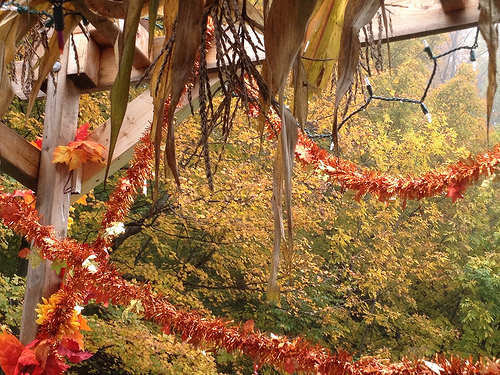
2.
Every day the sukkah becomes
more a sketch of itself,
beams hinting at emptiness.
The canvas walls dip
and the cornstalks wither,
revealing variegated sky.
Today we plead "save us."
Today we beat willow branches
until the leaves fall.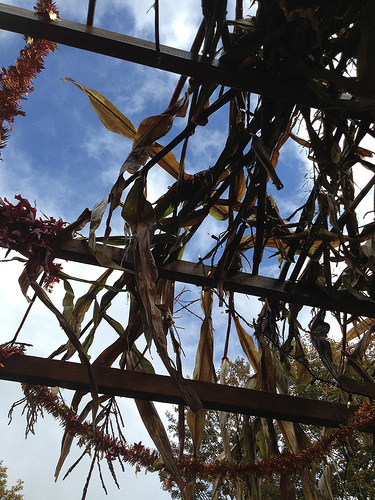
3.
The end of this long walk
through fasts and feasts:
we're footsore, hearts weary
from pumping emotion. We yearn
to burrow into the soil
and close our eyes. We won't know
what's been planted in us
until the sting of horseradish
pulls us forth into freedom.
This is a revision of the poem I posted earlier as a poem for Hoshanna Rabbah.
September 30, 2012
How to build a sukkah
On the morning after Yom Kippur, call the local deli/nursery/farmer's market. Ask if they have ornamental corn stalks for sale. Make a gleeful sound when the answer is yes. Drive over and buy four bunches.
Explain to the girl in the green t-shirt that there's a Jewish harvest festival where we spend a week sitting -- or living, or eating, or meditating -- outdoors, in flimsy houses with roofs made of organic material. Wonder what she's thinking.
Try to stuff the corn stalks into your car. Try a different way. Squint at the hatchback.
Remove them and sheepishly ask if you can buy some twine. Stand around feeling useless while the young man in the green t-shirt whips out his Leatherman, flicks it open, and binds the cornstalks to the roof of the car.
Go to Target. Consider, but discard, the glitter-covered pumpkin ornaments. Choose three metallic autumn-colored pumpkins instead.
Notice that the Christmas lights are on sale, already. Find yourself, for once, delighted that the retail Christmas season apparently begins in September. Buy two bins of little white lights, and one of purple-and-orange lights on impulse.
Pick up two autumn-leaf-themed plastic placemats. Print Sukkot blessings and affix them to the placemats with clear packing tape. Punch holes in the edges and attach some string. Admire your handiwork and wish it were Sukkot already.
Wait for your husband to come home and assemble the big wooden sukkah frame he built last year.
Spend four days trying to resist obsessively checking the weather forecast to see whether you'll be able to spend any of the week in the sukkah.
Wake in the night to the sound of pouring rain. Burrow deeper into your comforter.
When Sunday afternoon rolls around, listen to the whine of the drill driving screws into waterlogged wood.
Once the frame is standing, shrug into a raincoat and head outside. Wrap the walls in old canvas. Drag wet cornstalks across the lawn and heave them one by one onto the roof, the least aerodynamic javelins ever.
Twine garlands and strings of lights. Take off your eyeglasses because they're fogged-up and water-spattered.
When the last ornament is hung, wipe your brow and notice that the rain has stopped falling. There's even a patch of blue visible through the holes in the roof.
Rachel Barenblat's Blog
- Rachel Barenblat's profile
- 6 followers


